radio CHEVROLET EXPRESS 1997 1.G Owner's Manual
[x] Cancel search | Manufacturer: CHEVROLET, Model Year: 1997, Model line: EXPRESS, Model: CHEVROLET EXPRESS 1997 1.GPages: 386, PDF Size: 20.32 MB
Page 150 of 386
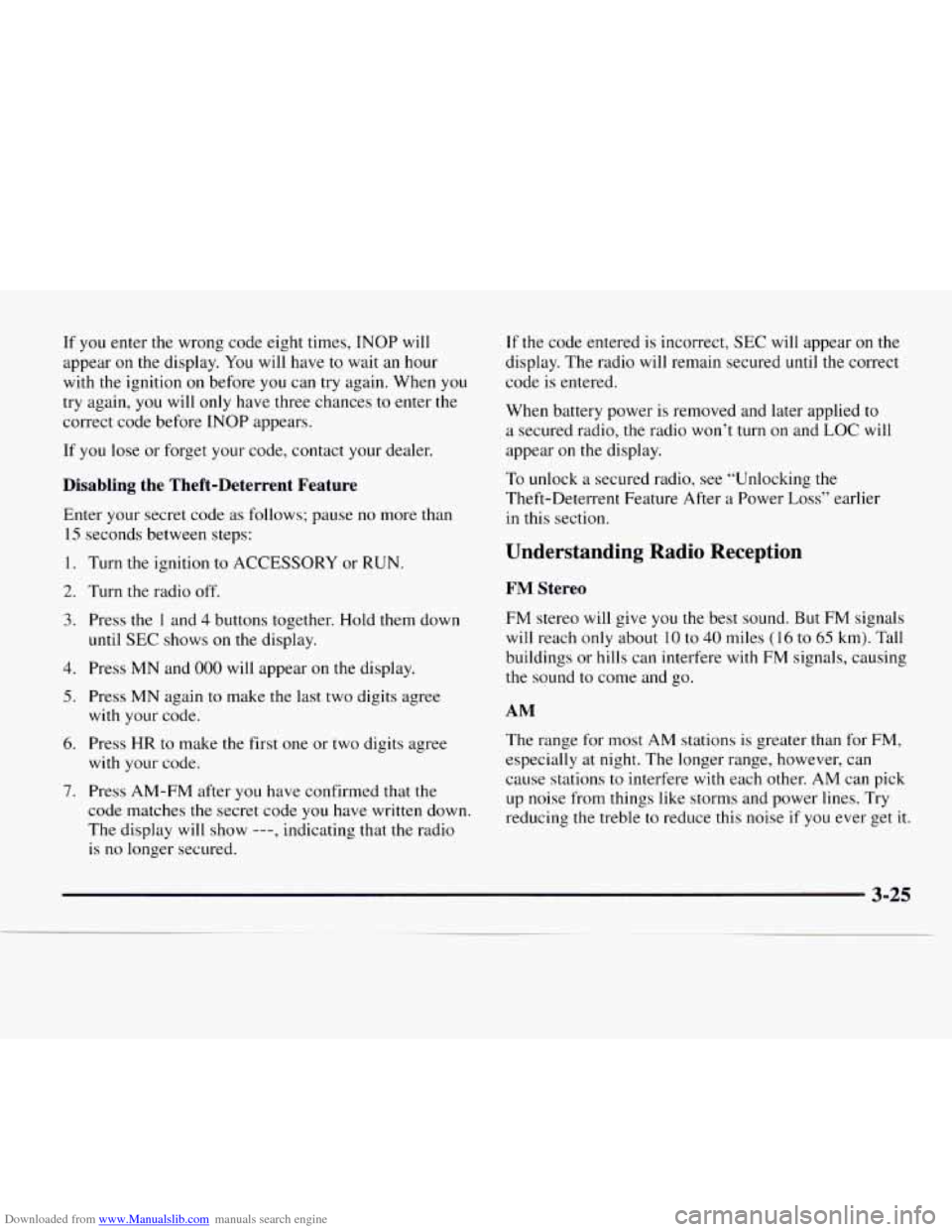
Downloaded from www.Manualslib.com manuals search engine If you enter the wrong code eight times, INOP will
appear
on the display. You will have to wait an hour
with the ignition
on before you can try again. When you
try again,
you will only have three chances to enter the
correct code before
INOP appears.
If
you lose or forget your code, contact your dealer.
Disabling the Theft-Deterrent Feature
Enter your secret code as follows; pause no more than
15 seconds between steps:
1. Turn the ignition to ACCESSORY or RUN.
2. Turn the radio off.
3. Press the 1 and 4 buttons together. Hold them down
4. Press MN and 000 will appear on the display.
until
SEC shows on the display.
5. Press MN again to make the last two digits agree
with your code.
with your code.
6. Press HR to make the first one or two digits agree
7. Press AM-FM after you have confirmed that the
code matches
the secret code you have written down.
The display will show
---, indicating that the radio
is
no longer secured.
If the code entered is incorrect, SEC will appear on the
display. The radio will remain secured until the correct
code is entered.
When battery power is removed and later applied to
a secured radio, the radio won’t turn
on and LOC will
appear on the display.
To unlock
a secured radio, see “Unlocking the
Theft-Deterrent Feature After
a Power Loss” earlier
in this section.
Understanding Radio Reception
FM Stereo
FM stereo will give you the best sound. But FM signals
will reach only about
10 to 40 miles (16 to 65 km). Tall
buildings or hills can interfere with
FM signals, causing
the sound
to come and go.
AM
The range for most AM stations is greater than for FM,
especially at night. The longer range, however, can
cause stations to interfere with each other. AM can pick
up noise from things like storms and power lines. Try
reducing
the treble to reduce this noise if you ever get it.
3-25
Page 151 of 386
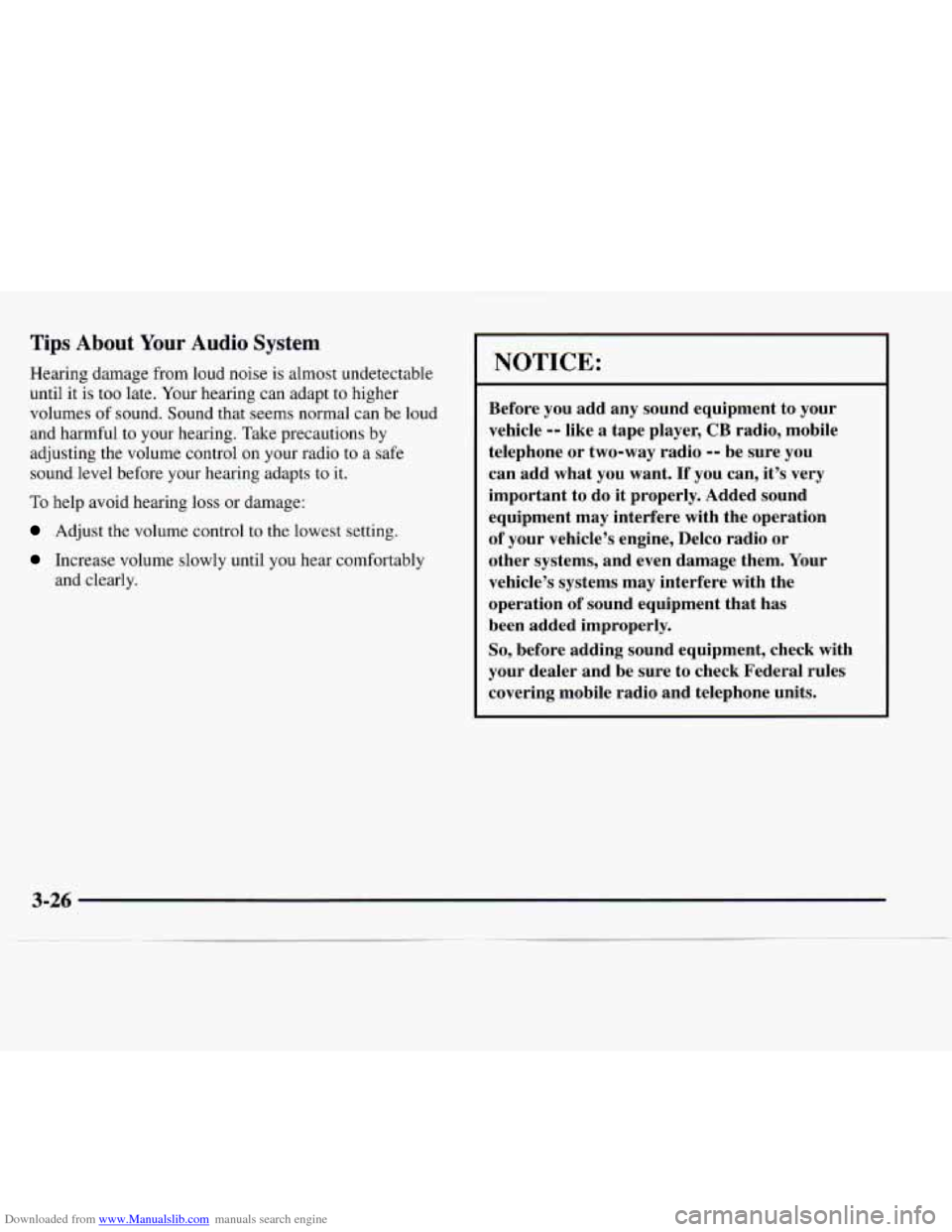
Downloaded from www.Manualslib.com manuals search engine Tips About Your Audio System
Hearing damage from loud noise is almost unaerectable
until it is too late. Your hearing can adapt to higher
volumes of sound. Sound that
seems normal can be loud
and harmful to your hearing. Take precautions by
adjusting the volume control
on your radio to a safe
sound level before your hearing adapts to it.
To help avoid hearing loss or damage:
Adjust the volume control to the lowest setting.
Increase volume slowly until you hear comfortably
and clearly.
I
NOTICE:
Before you add any sound equipment to your
vehicle
-- like a tape player, CB radio, mobile
telephone or two-way radio
-- be sure you
can add what you want.
If you can, it’s very
important to do it properly. Added sound
equipment may interfere with the operation
of your vehicle’s engine, Delco radio or
other systems, and even damage them. Your
vehicle’s systems may interfere with the
operation
of sound equipment that has
been added improperly.
So, before adding sound equipment, check with
your dealer and be sure to check Federal rules
covering mobile radio and telephone units.
3-26
Page 152 of 386
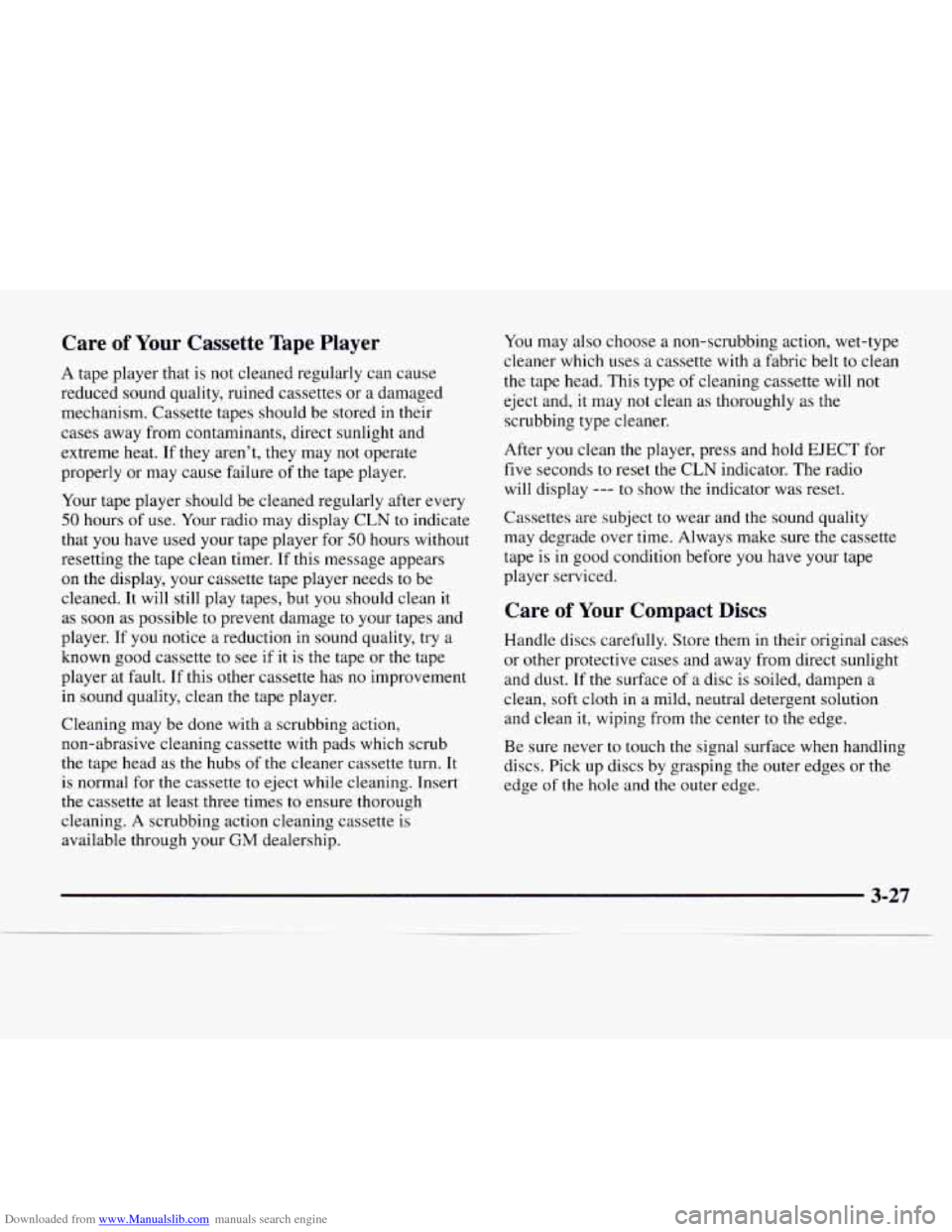
Downloaded from www.Manualslib.com manuals search engine Care of Your Cassette Tape Player
A tape player that is not cleaned regularly can cause
reduced sound quality, ruined cassettes or a damaged
mechanism. Cassette tapes should be stored in their
cases away from contaminants, direct sunlight and
extreme heat. If they aren’t, they may not operate
properly or may cause failure
of the tape player.
Your tape player should be cleaned regularly after every
50 hours of use. Your radio may display CLN to indicate
that you have used your tape player for
50 hours without
resetting the tape clean timer. If this message appears
on the display, your cassette tape player needs to be
cleaned. It will still play tapes, but you should clean it
as soon as possible to prevent damage to your tapes and
player. If you notice a reduction in sound quality, try a
known good cassette
to see if it is the tape or the tape
player at fault.
If this other cassette has no improvement
in sound quality, clean the tape player.
Cleaning may be dc
: with a scrubbing action,
non-abrasive cleaning cassette with pads which scrub
the tape head as the hubs
of the cleaner cassette turn. It
is normal for the cassette to eject while cleaning. Insert
the cassette at least three times to ensure thorough
cleaning. A scrubbing action cleaning cassette is
available through your
GM dealership. You
may also choose a non-scrubbing action, wet-type
cleaner which uses a cassette with a fabric belt to clean
the tape head. This type of cleaning cassette will not
eject and, it may not clean as thoroughly as the
scrubbing type cleaner.
After you clean the player, press and hold EJECT for
five seconds
to reset the CLN indicator. The radio
will display
--- to show the indicator was reset.
Cassettes are subject
to wear and the sound quality
may degrade over time. Always make sure the cassette
tape is in good condition before you have your tape
player serviced.
Care of Your Compact Discs
Handle discs carefully. Store them in their original cases
or other protective cases and away from direct sunlight
and dust.
If the surface of a disc is soiled, dampen a
clean,
soft cloth in a mild, neutral detergent solution
and clean it, wiping from the center to the edge.
Be sure never
to touch the signal surface when handling
discs. Pick up discs by grasping the outer edges or the
edge
of the hole and the outer edge.
3-27
Page 153 of 386
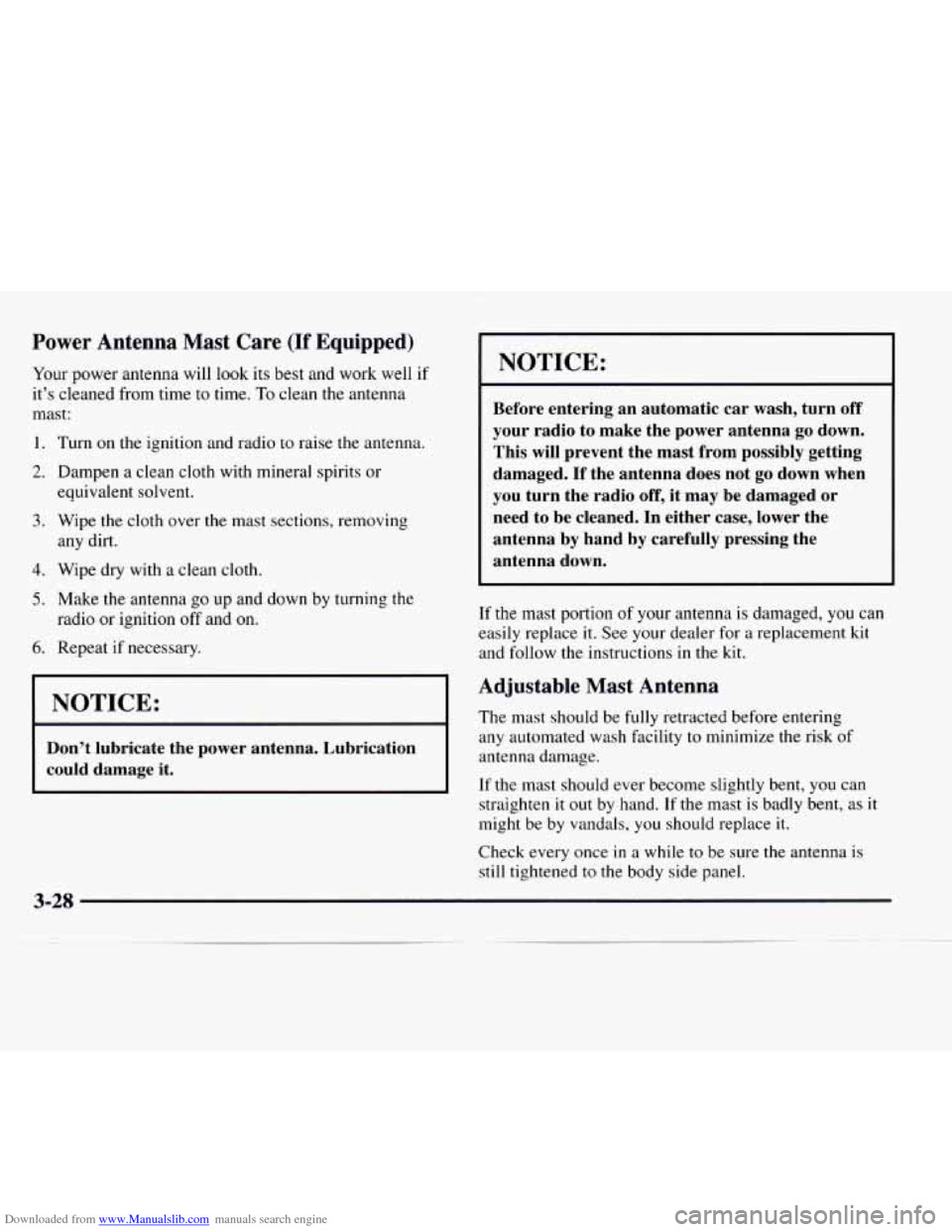
Downloaded from www.Manualslib.com manuals search engine Power Antenna Mast Care (If Equipped)
Your power anteilfia will look its best and work well if
it’s cleaned from time to time.
To clean the antenna
mast:
1.
2.
3.
4.
5.
6.
Turn on the ignition and radio to raise the antenna.
Dampen
a clean cloth with mineral spirits or
equivalent solvent.
Wipe the cloth over the mast sections, removing
any dirt.
Wipe dry with
a clean cloth.
Make
the antenna go up and down by turning the
radio or ignition
off and on.
Repeat if necessary.
I NOTICE:
Don’t lubricate the power antenna. Lubrication
could damage it.
I
NOTICE:
Before entering an automatic car wash, turn off
your radio to make the power antenna go down.
This will prevent the mast from possibly getting
damaged.
If the antenna does not go down when
you turn the radio off, it may be damaged
or
need to be cleaned. In either case, lower the
antenna by hand by carefully pressing the
antenna down.
If the mast portion of your antenna is damaged, you can
easily replace it. See your dealer for a replacement kit
and follow the instructions in the kit.
Adjustable Mast Antenna
The mast should be fully retracted before entering
any automated wash facility to minimize the risk of
antenna damage.
If the mast should ever become slightly bent, you can
straighten
it out by hand. If the mast is badly bent, as it
might be by vandals,
you should replace it.
Check every once in a while to be sure the antenna is
still tightened to the body side panel.
3-28
Page 197 of 386
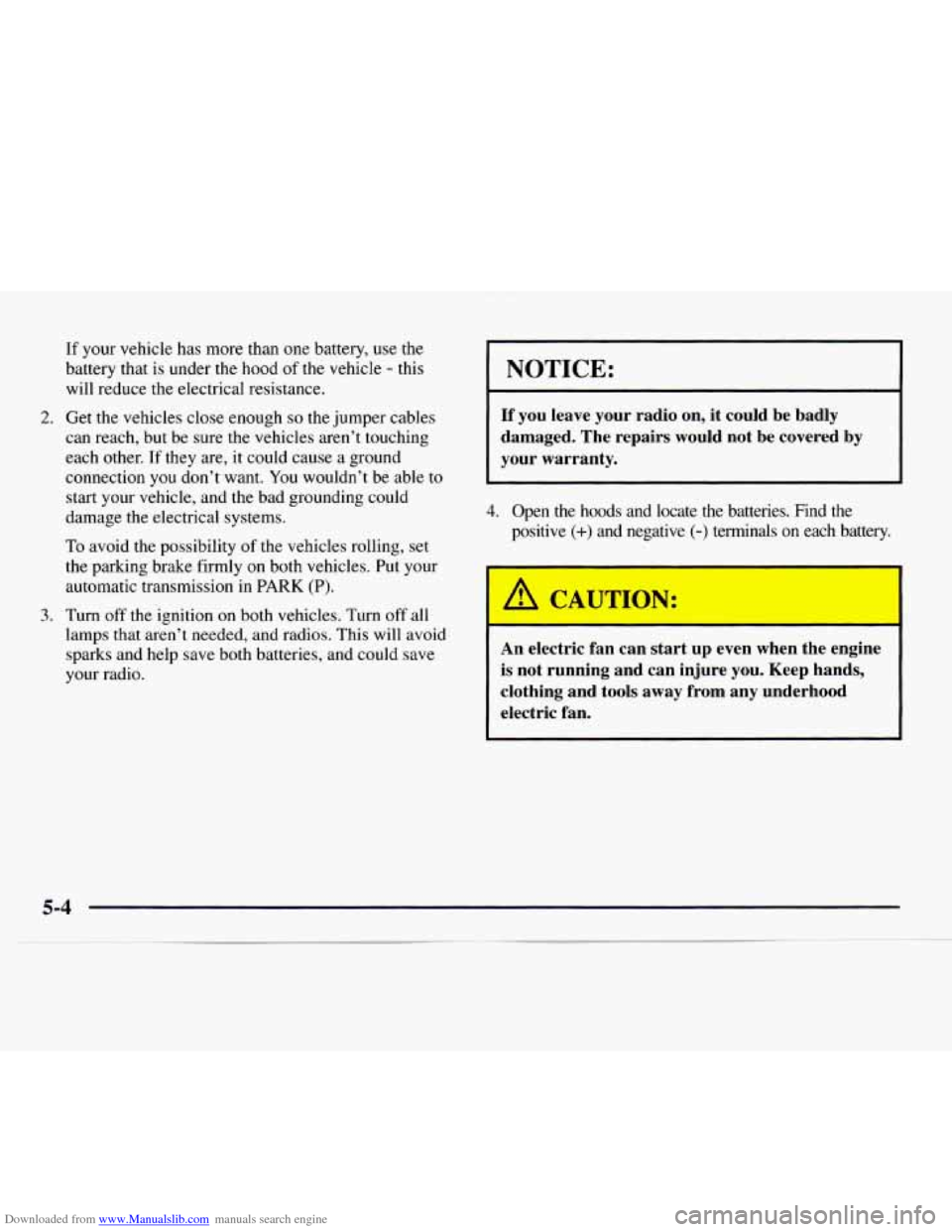
Downloaded from www.Manualslib.com manuals search engine If your vehicle has more than one battery, use the
battery that is under the hood of the vehicle
- this
will reduce the electrical resistance.
2. Get the vehicles close enough so the jumper cables
can reach, but be sure the vehicles aren’t touching
each other.
If they are, it could cause a ground
connection
you don’t want. You wouldn’t be able to
start your vehicle, and the bad grounding could
damage the electrical systems.
To avoid the possibility of the vehicles rolling, set
the parking brake firmly on both vehicles. Put your
automatic transmission in PARK
(P).
3. Turn off the ignition on both vehicles. Turn off all
lamps that aren’t needed, and radios. This will avoid
sparks and help save both batteries, and could save
your radio.
1 NOTICE:
If’ you leave your radio on, it could be badly
damaged. The repairs would not be covered by
your warranty.
4. Open the hoods and locate the batteries. Find the
positive
(+) and negative (-) terminals on each battery.
An electric fan can start up even when the engine
is not running and can injure you. Keep hands,
clothing and tools away from any underhood
electric fan.
Page 293 of 386
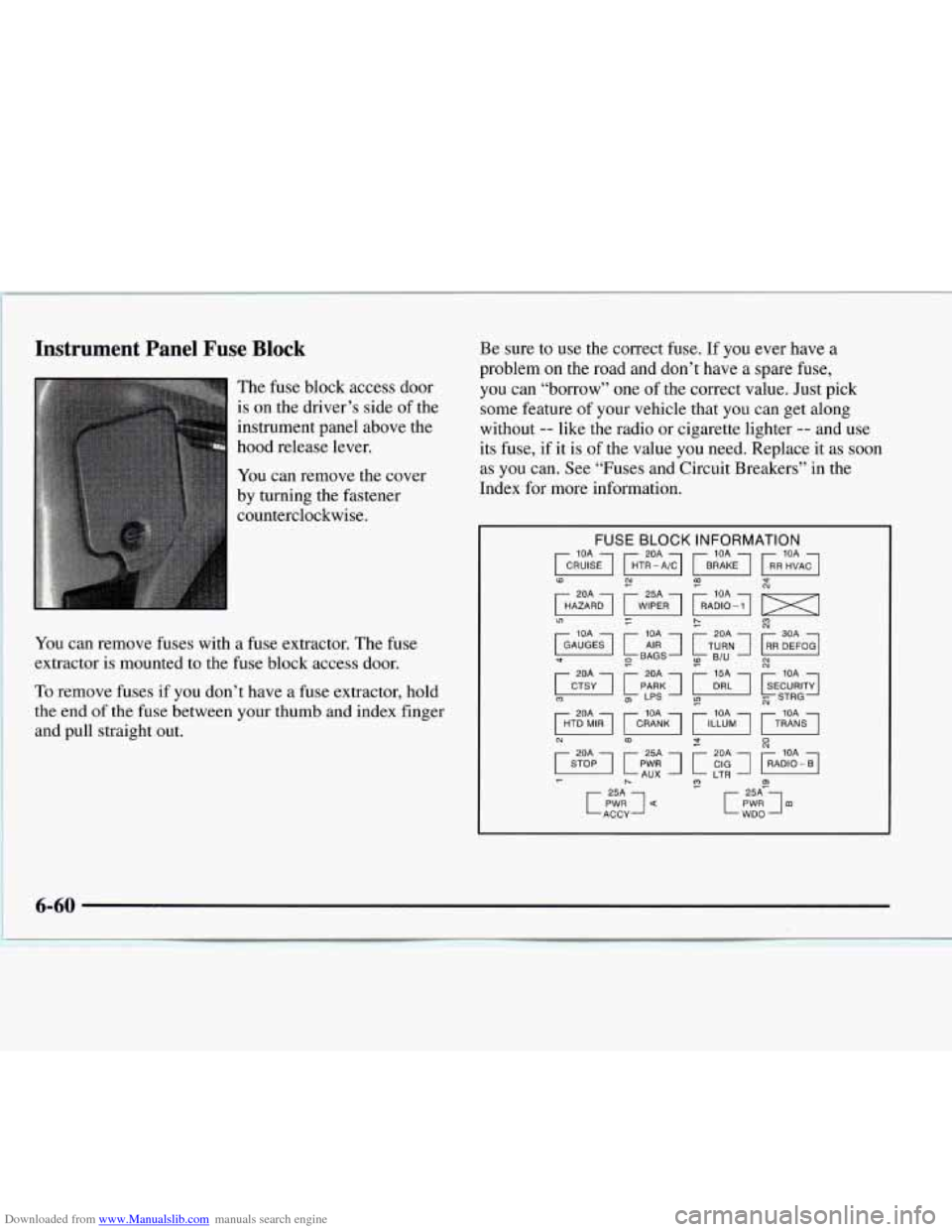
Downloaded from www.Manualslib.com manuals search engine Instrument Panel Fuse Block
The fuse block access door
is on the driver's side of the
instrument panel above the
hood release lever.
You can remove the cover
by turning the fastener
counterclockwise.
You can remove fuses with a fuse extractor. The fuse
extractor
is mounted to the fuse block access door.
To remove fuses if you don't have a fuse extractor, hold
the end of the fuse between your thumb and index finger
and pull straight out. Be sure to use
the correct fuse.
If you ever have a
problem on the road and don't have a spare fuse,
you can "borrow" one of the correct value. Just pick
some feature of your vehicle that you can get along
without
-- like the radio or cigarette lighter -- and use
its fuse, if it is of the value you need. Replace it
as soon
as you can. See "Fuses and Circuit Breakers'' in the
Index for more information.
6-60
Page 294 of 386
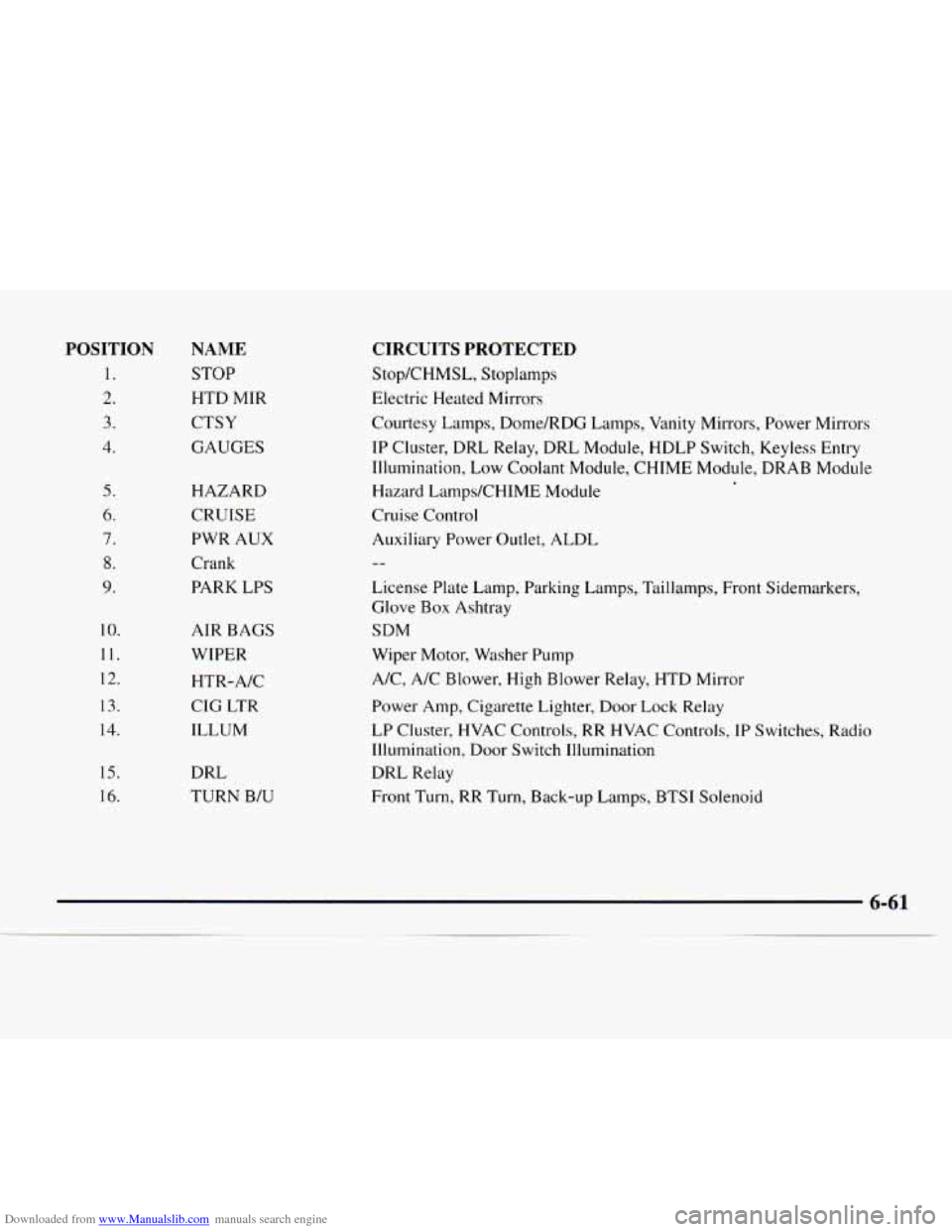
Downloaded from www.Manualslib.com manuals search engine POSITION
1.
2.
3.
4.
5.
6.
7.
8.
9.
10.
11.
12.
13.
14.
1s.
16.
NAME
STOP
HTD MIR
CTSY
GAUGES
HAZARD
CRUISE
PWR AUX
Crank
PARK LPS
AIR BAGS
WIPER
HTR-A/C
CIG LTR
ILLUM
DRL
TURN B/U
CIRCUITS PROTECTED
Stop/CHMSL, Stoplamps
Electric Heated Mirrors
Courtesy
Lamps, Dorne/RDG Lamps, Vanity Mirrors, Power Mirrors
IP Cluster, DRL Relay, DRL Module, HDLP Switch, Keyless Entry
Illumination, Low Coolant Module, CHIME Module, DRAB Module
Hazard Lamps/CHIME Module
Cruise Control
Auxiliary Power Outlet, ALDL
.
License Plate Lamp, Parking Lamps, Tdillamps, Front Sidemarkers,
Glove
Box Ashtray
SDM
Wiper Motor, Washer Pump
A/C, A/C Blower, High Blower Relay, HTD Mirror
Power Amp, Cigarette Lighter, Door Lock Relay
LP Cluster, HVAC Controls, RR HVAC Controls, IP Switches, Radio
Illumination, Door Switch Illumination
DRL Relay
Front Turn,
RR Turn, Back-up Lamps, BTSI Solenoid
Page 295 of 386
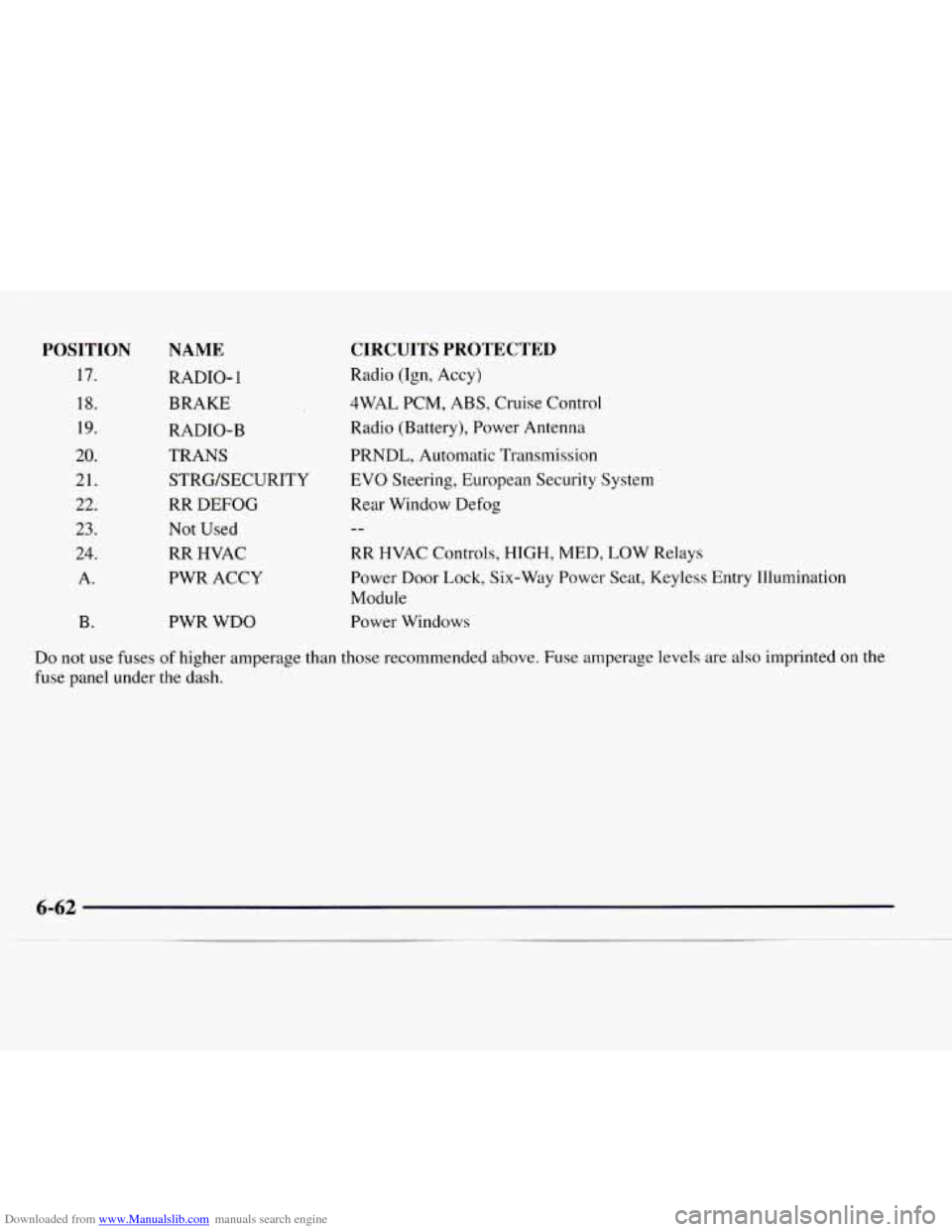
Downloaded from www.Manualslib.com manuals search engine POSITION
17.
18.
19.
20.
21.
22.
23.
24. A.
B.
NAME
RADIO- 1
BRAKE
RADIO-B
TRANS STRGEECURITY
RR DEFOG
Not Used
RR HVAC
PWR ACCY
PWR WDO
CIRCUITS PROTECTED
Radio (Ign, Accy)
4WAL PCM, ABS, Cruise Control
Radio (Battery), Power Antenna
PRNDL, Automatic Transmission
EVO Steering, European Security System
Rear Window Defog
RR HVAC Controls, HIGH, MED,
LOW Relays
Power Door Lock, Six-Way Power Seat, Keyless Entry Illumination
Module
Power Windows
Do not
use fuses of higher amperage than those recommended above. Fuse amperage levels are also imprinted on the
fuse panel under the dash.
Page 380 of 386
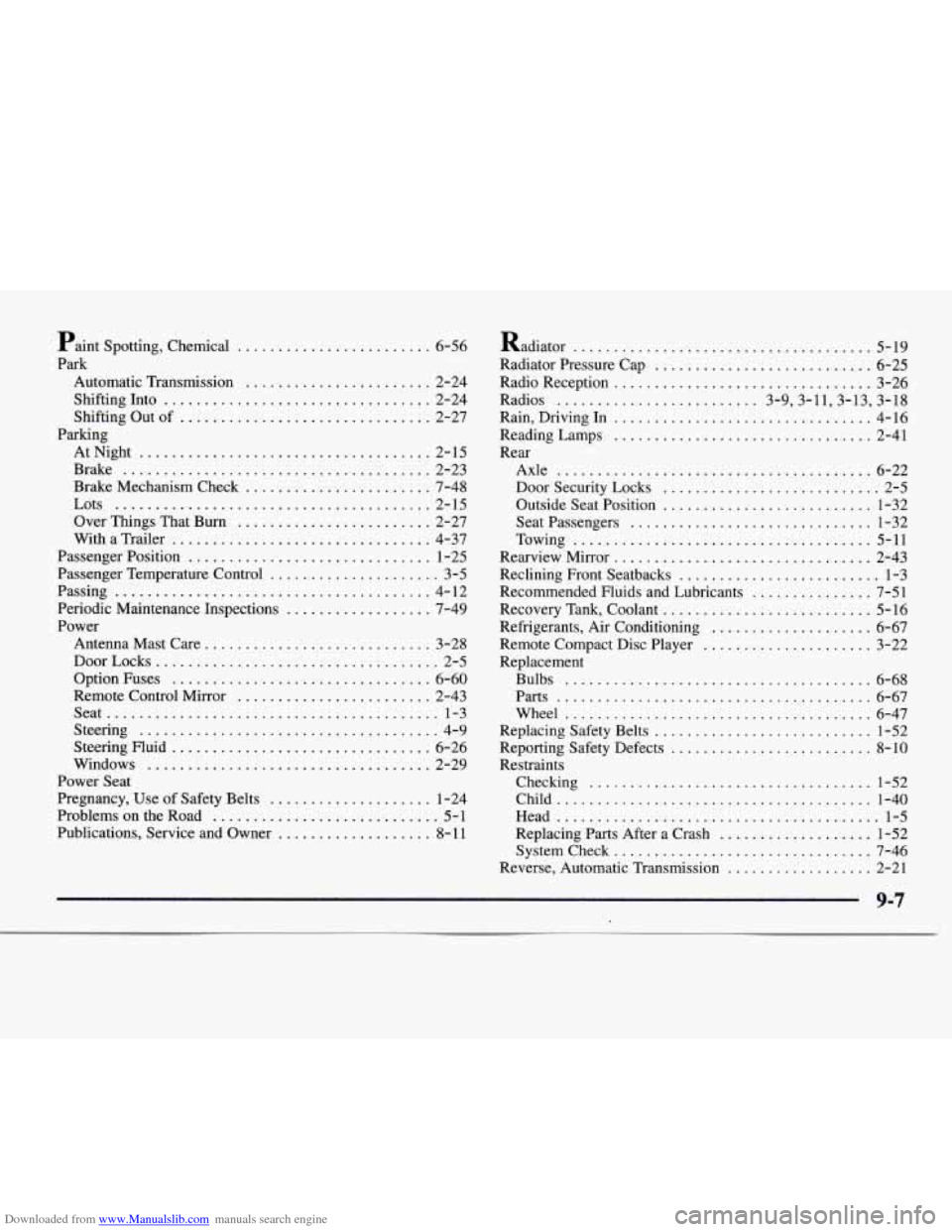
Downloaded from www.Manualslib.com manuals search engine Paint Spotting. Chemical ........................ 6-56
Park Automatic Transmission
....................... 2-24
Shifting Out of
............................... 2-27
AtNight
.................................... 2-15
Brake
...................................... 2-23
Brake Mechanism Check
....................... 7-48
Lots
....................................... 2-15
OverThingsThatBurn
........................ 2-27
With a Trailer
................................ 4-37
Passenger Position
.............................. 1-25
Passenger Temperature Control
..................... 3-5
Passing
....................................... 4-12
Periodic Maintenance Inspections
.................. 7-49
Power
Antenna Mast Care
............................ 3-28
DoorLocks
................................... 2-5
Option Fuses
................................ 6-60
Remote Control Mirror
........................ 2-43
Seat
......................................... 1-3
Steering ..................................... 4-9
Steering Fluid
................................ 6-26
Windows
................................... 2-29
Power Seat
Pregnancy. Use of Safety Belts
.................... 1-24
Problems on the Road
............................ 5-1
Publications. Service and Owner ................... 8-1 1
Shifting Into ................................. 2-24
Parking Radiator
..................................... 5-19
Radiator Pressure Cap
............................ 6-25
Radio Reception
................................ 3-26
Radios
......................... 3.9.3.11.3.13. 3.18
Rain. Driving In
................................ 4-16
Reading Lamps
................................ 2-41
Rear Axle
....................................... 6-22
Door Security Locks
........................... 2-5
Outside Seat Position
.......................... 1-32
Seatpassengers
.............................. 1-32
Towing
..................................... 5-11
Rearview Mirror
................................ 2-43
Reclining Front Seatbacks
......................... 1-3
Recommended Fluids and Lubricants
............... 7-51
Recovery Tank. Coolant
.......................... 5-16
Refrigerants. Air Conditioning
.................... 6-67
Remote Compact Disc Player
..................... 3-22
Replacement Bulbs
...................................... 6-68
Parts
....................................... 6-67
Wheel
...................................... 6-47
Replacing Safety Belts
........................... 1-52
Reporting Safety Defects
......................... 8-10
Restraints
Checking
................................... 1-52
Child
....................................... 1-40
Head
........................................ 1-5
System Check
................................ 7-46
Reverse. Automatic Transmission
.................. 2-21
Replacing Parts After
a Crash
................... 1-52
9-7